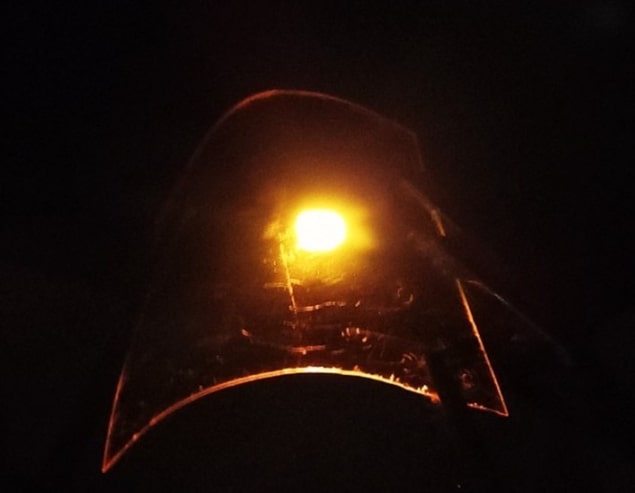Flexible organic LED produces ‘romantic’ candle-like light
29 Jun 2022 Isabelle Dumé

A new bendable organic light-emitting diode (OLED) that produces warm, candle-like light with hardly any emissions at blue wavelengths might find a place in flexible lighting and smart displays that can be used at night without disrupting the body’s biological clock. The device, which is an improved version of one developed recently by a team of researchers from National Tsing Hua University in Taiwan, is made from a light-emitting layer on a mica substrate that is completely free of plastic.
Jwo-Huei Jou and Ying-Hao Chu of the National Tsing Hua University’s Department of Materials Science and Engineering and colleagues recently patented OLEDS that produce warm, white light. However, these earlier devices still emit some unwanted blue light, which decreases the production of the “sleep hormone” melatonin and can therefore disrupt sleeping patterns. A further issue is that these OLEDs were made of solid materials and were therefore not flexible.
Mica, a natural layered mineral
One way to make OLEDs flexible is to paste them onto a plastic backing, but most plastics cannot be bent repeatedly – a prerequisite for real-world flexible applications. Jou, Chu and colleagues therefore decided to investigate backings made from mica, a natural layered mineral that can be cleaved into bendable, transparent sheets.
The researchers began by depositing a clear indium tin oxide (ITO) film onto a mica sheet as the LED’s anode. They then mixed a luminescent material, N,N’-dicarbazole-1,1’-biphenyl, with red and yellow phosphorescent dyes to fabricate the device’s light-emitting layer. Next, they sandwiched this layer between electrically conductive solutions with the anode on one side and an aluminium layer in the other to create a flexible OLED.
Tests showed that when coated with a transparent conductor, the mica substrate is robust to bending curvatures of 1/5 mm-1 – a record high – and 50 000 bending cycles at a 7.5 mm bending radius. The OLED is also highly resistant to moisture and oxygen and has a lifetime that is 83% of similar devices on glass.
“Romantic” light
The new device emits bright, warm light upon the application of a constant current. This light contains even less blue-wavelength light than natural candlelight, Jou and Chu report, meaning that the exposure limit for humans is 47 000 seconds compared to just 320 s for a cold-white counterpart, according to the team’s calculations. This means that a person exposed to the OLED for 1.5 hours would see their melatonin production suppressed by about 1.6%, compared to 29% for a cold-white compact fluorescent lamp over the same period.READ MORE

“We have fabricated an OLED emitting a psychologically-warm but physically-cool, scorching-free romantic candle-like light on a bendable mica substrate using our patented candlelight OLED technology,” Jou tells Physics World. “This technology could provide designers and artists with more freedom in designing variable lighting systems that fit into different spaces, thanks to their flexibility.”
The researchers now hope to make their OLEDs completely transparent. “When lit, these candlelight OLEDs could then be seen from both sides,” Chu says.
The present work is detailed in ACS Applied Electronic Materials.

Isabelle Dumé is a contributing editor to Physics World
from physicsworld.com 29/6/2022
Δεν υπάρχουν σχόλια:
Δημοσίευση σχολίου